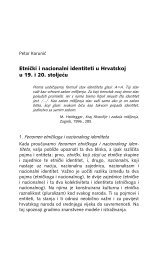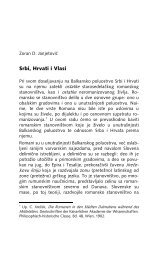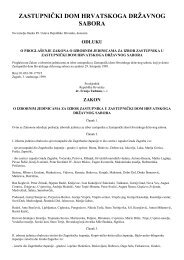1.3.1.A. Habsburški fortifikacijski sustav na jugoistoku Europe od ...
1.3.1.A. Habsburški fortifikacijski sustav na jugoistoku Europe od ...
1.3.1.A. Habsburški fortifikacijski sustav na jugoistoku Europe od ...
You also want an ePaper? Increase the reach of your titles
YUMPU automatically turns print PDFs into web optimized ePapers that Google loves.
Josip Kljajić 47Handels und der Dienstleistungen entwickelt haben, die Lebensqualitätverbessert haben.Die bauliche Gestaltung der Festungen stimmte mit dem Entwicklungsstanddes Geschützes und der Art der Kriegführung überein, undsie war auch von der geschichtlichen Situation und künstlerischenOrientierung beeinflußt, was alles zu ständigen Veränderungen undEntwicklung geführt hat. Jede Innovation einerseits resultierte inentsprechender Antwort andererseits. Die Antwort der Festungsplanerbestand jedoch meistens in baulichen Anpassungen, wobei militärischeBaumeister diverse Anbauten auf bestehendem Mauerwerk <strong>od</strong>er aufder Verteidigungslinie errichteten. Eine solche komplexe Verteidigungwurde von den gebildetsten Menschen vorbereitet, so daß sich infolgedessen das Festungssystem mit Basteien fast 300 Jahre lang als einsehr erfolgreiches europäisches Verteidigungsm<strong>od</strong>ell bewährt hat.SummaryThe construction of m<strong>od</strong>ern fortresses from the end of the 17thcentury to the middle of the 18th century in the south-east of <strong>Europe</strong>,in Stara Gradiška, Br<strong>od</strong>, Rača, Osijek, Petrovaradin and Belgrade,depended not only on their <strong>na</strong>tural location but also on the inheritedstructures of the past or those constructed at the time. The commoncharacteristic of fortresses with this fortification system is theirbaroque style, which is evident from their geometrically indented (starlike)plan. This shows that their fortification architecture was strictlyshaped and made of many defence walls. Fortresses were organised asself-sufficient units and around their walls other facilities were built inorder to cater for military needs. In other words, the presence ofincreasing number of consumers (army) led to higher consumption,which positively influenced and helped the development of towns.Therefore the presence of officers, who were used to a higherstandard of living, encouraged the development of specialised types ofcrafts, trades and services, which in turn improved the quality of life.Architectural design of these fortresses was in accordance with thecharacteristics of artillery weapons and way of warfare. It also sto<strong>od</strong>under the influence of historical circumstances and artistic expressionof the time, which by continual interaction encouraged constantchange and development. Every innovation on one of these levels
















